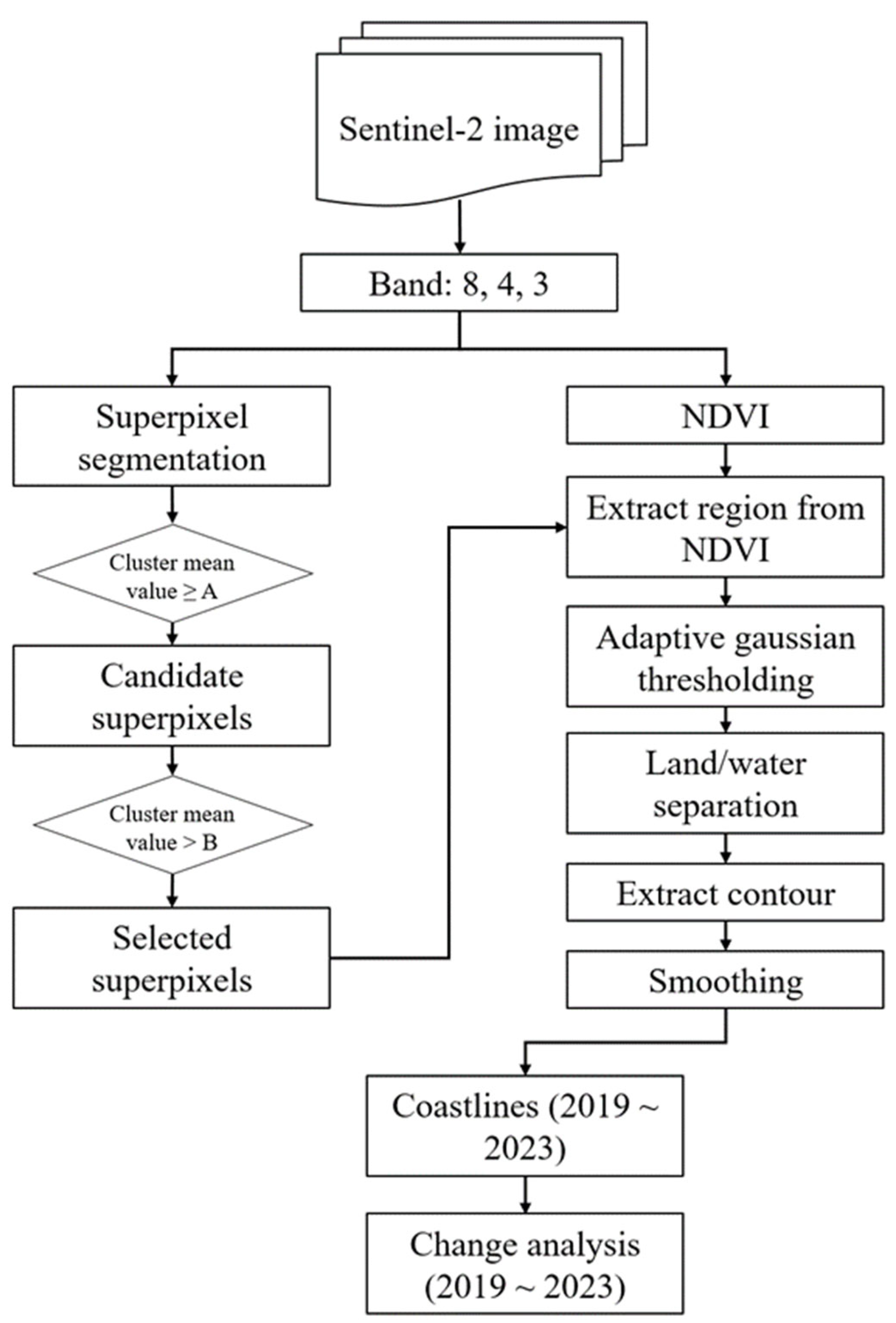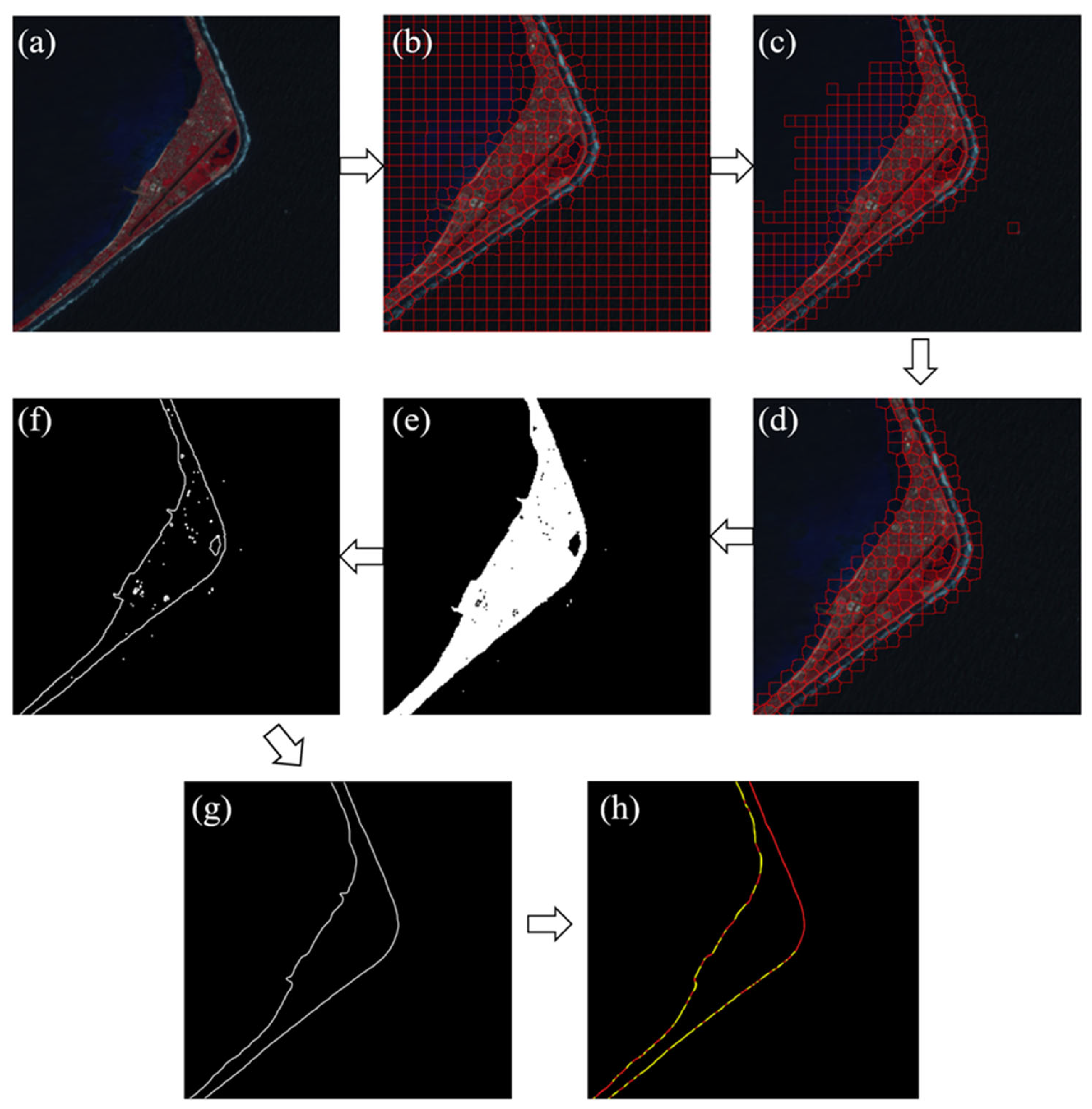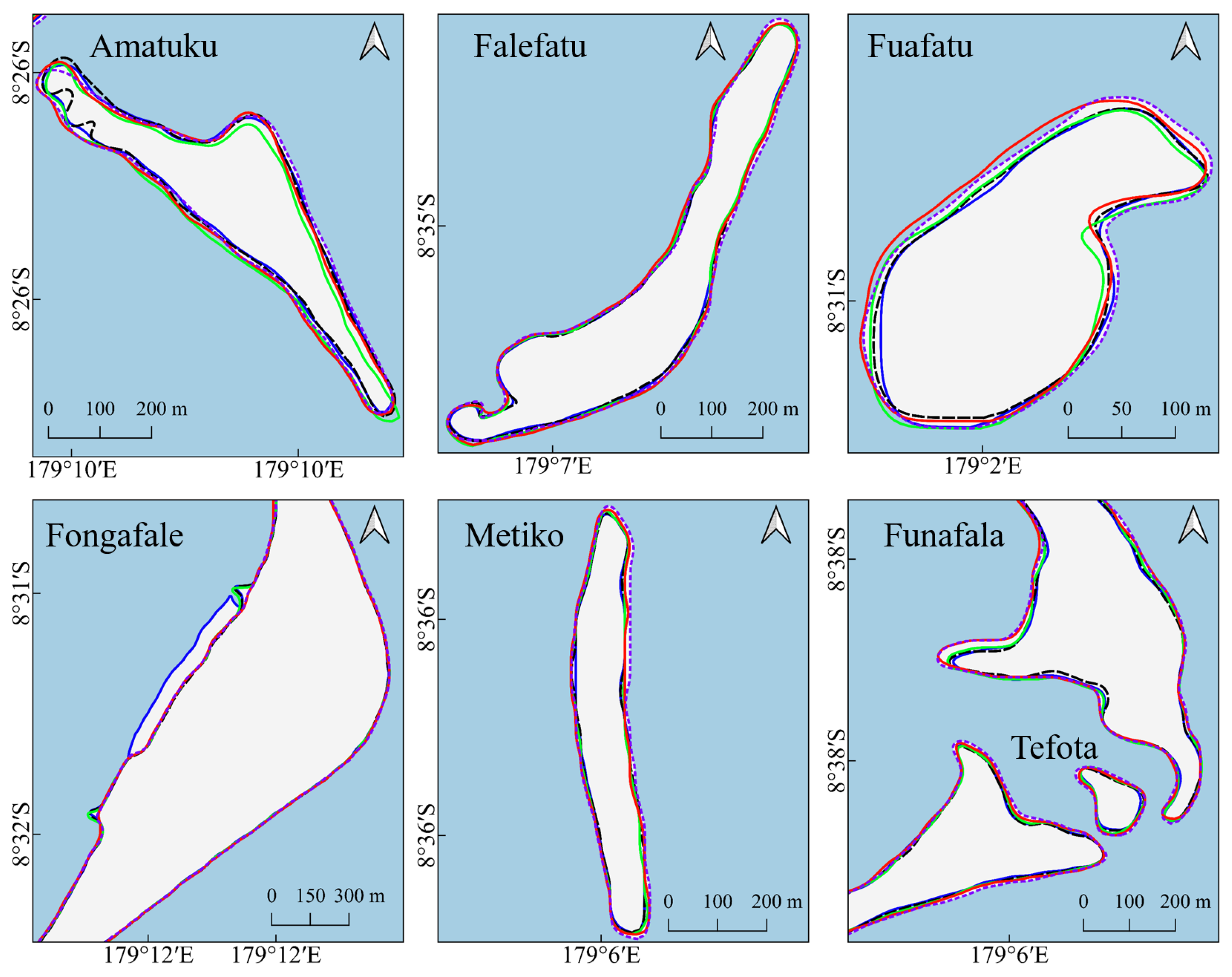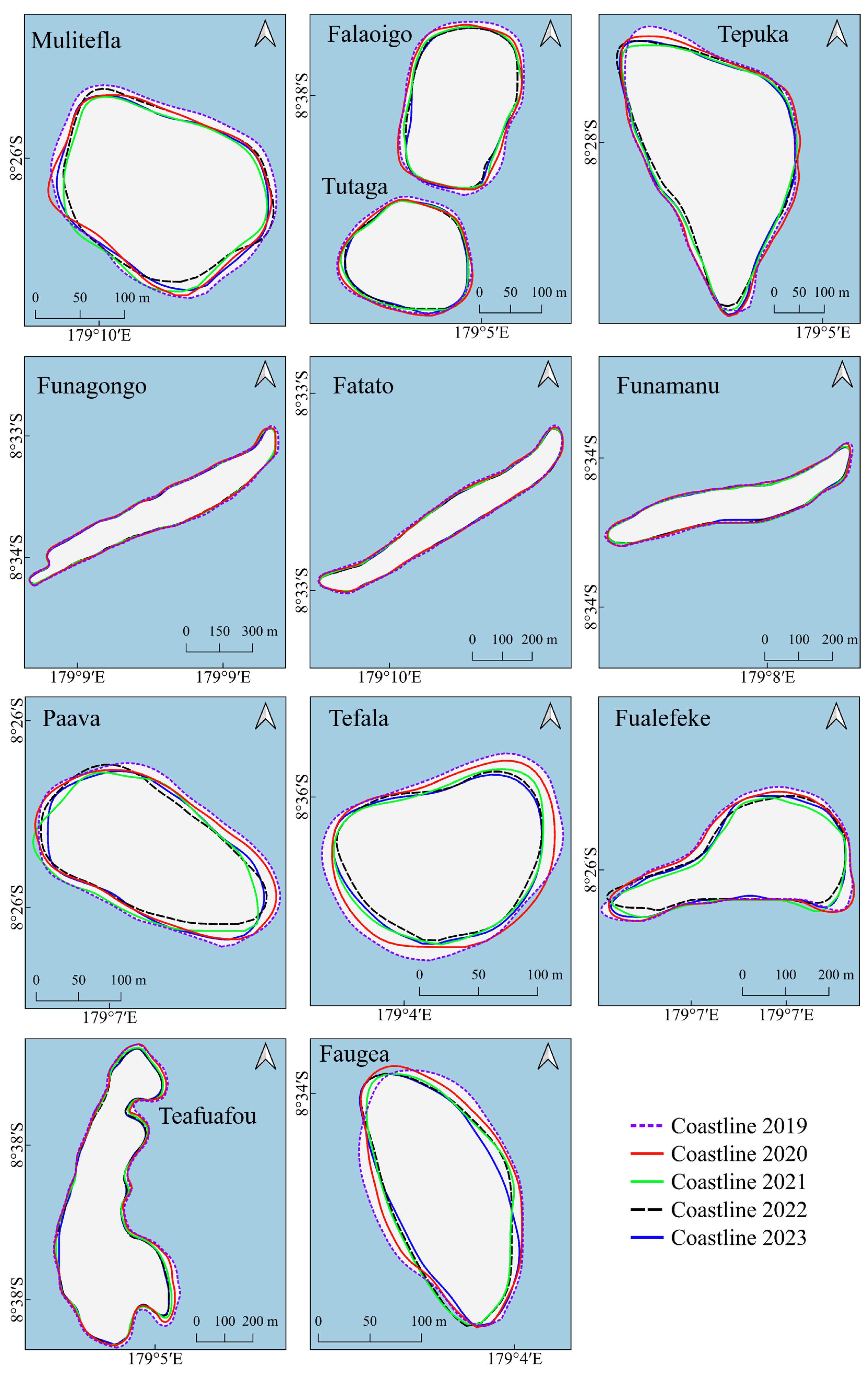A Study on the Coastline Extraction and Coastal Change Analysis Using Sentinel-2 Imagery in Funafuti, Tuvalu
Abstract
1. Introduction
2. Materials and Methods
2.1. Study Area and Data
2.2. Methodology
3. Results
3.1. Coastline Extraction Result Between the Years 2019 and 2023
3.2. Coastal Changes Between the Years 2019 and 2023
4. Discussion
5. Conclusions
Author Contributions
Funding
Data Availability Statement
Conflicts of Interest
References
- Small, C.; Nicholls, R.J. A global analysis of human settlement in coastal zones. J. Coast. Res. 2003, 19, 584–599. [Google Scholar]
- Minghelli, A.; Spagnoli, J.; Lei, M.; Chami, M.; Charmasson, S. Shoreline extraction from WorldView2 satellite data in the presence of foam pixels using multispectral classification method. Remote Sens. 2020, 12, 2664. [Google Scholar] [CrossRef]
- Saleem, A.; Awange, J.L. Coastline shift analysis in data deficient regions: Exploiting the high spatio-temporal resolution Sentinel-2 products. Catena 2019, 179, 6–19. [Google Scholar] [CrossRef]
- Dolan, R.; Fenster, M.S.; Holme, S.J. Temporal analysis of shoreline recession and accretion. J. Coast. Res. 1991, 7, 723–744. [Google Scholar]
- Wu, X.; Liu, C.; Wu, G. Spatial-temporal analysis and stability investigation of coastline changes: A case study in Shenzhen, China. IEEE J. Sel. Top. Appl. Earth Obs. Remote Sens. 2018, 11, 45–56. [Google Scholar] [CrossRef]
- Alesheikh, A.A.; Ghorbanali, A.; Nouri, N. Coastline change detection using remote sensing. Int. J. Environ. Sci. Technol. 2007, 4, 61–66. [Google Scholar] [CrossRef]
- Boak, E.H.; Turner, I.L. Shoreline definition and detection: A review. J. Coast. Res. 2005, 21, 688–703. [Google Scholar] [CrossRef]
- Viaña-Borja, S.P.; Ortega-Sánchez, M. Automatic methodology to detect the coastline from Landsat images with a new water index assessed on three different Spanish Mediterranean deltas. Remote Sens. 2019, 11, 2186. [Google Scholar] [CrossRef]
- Holland, K.T.; Holman, R.A. Field observations of beach cusps and swash motions. Mar. Geol. 1996, 134, 77–93. [Google Scholar] [CrossRef]
- Masselink, G.; Russell, P.; Coco, G.; Huntley, D. Test of edge wave forcing during formation of rhythmic beach morphology. J. Geophys. Res. Ocean. 2004, 109, C06003. [Google Scholar] [CrossRef]
- Tang, W.; Zhao, C.; Lin, J.; Jiao, C.; Zheng, G.; Zhu, J.; Pan, X.; Han, X. Improved spectral water index combined with Otsu algorithm to extract muddy coastline data. Water 2022, 14, 855. [Google Scholar] [CrossRef]
- El-Asmar, H.M.; White, K. Changes in coastal sediment transport processes due to construction of New Damietta Harbour, Nile Delta, Egypt. Coast. Eng. 2002, 46, 127–138. [Google Scholar] [CrossRef]
- Pardo-Pascual, J.E.; Almonacid-Caballer, J.; Ruiz, L.A.; Palomar-Vázquez, J. Automatic extraction of shorelines from Landsat TM and ETM+ multi-temporal images with sub-pixel precision. Remote Sens. Environ. 2012, 123, 1–11. [Google Scholar] [CrossRef]
- Modava, M.; Akbarizadeh, G.; Soroosh, M. Integration of Spectral Histogram and Level Set for Coastline Detection in SAR Images. IEEE Trans. Aerosp. Electron. Syst. 2019, 55, 810–819. [Google Scholar] [CrossRef]
- Liu, C.; Xiao, Y.; Yang, J. A coastline detection method in polarimetric SAR images mixing the region-based and edge-based active contour models. IEEE Trans. Geosci. Remote Sens. 2017, 55, 3735–3747. [Google Scholar] [CrossRef]
- Paravolidakis, V.; Ragia, L.; Moirogiorgou, K.; Zervakis, M. Automatic Coastline Extraction Using Edge Detection and Optimization Procedures. Geosciences 2018, 8, 407. [Google Scholar] [CrossRef]
- Kuleli, T.; Guneroglu, A.; Karsli, F.; Dihkan, M. Automatic detection of shoreline change on coastal Ramsar wetlands of Turkey. Ocean Eng. 2011, 38, 1141–1149. [Google Scholar] [CrossRef]
- Li, W.; Gong, P. Continuous monitoring of coastline dynamics in western Florida with a 30-year time series of Landsat imagery. Remote Sens. Environ. 2016, 179, 196–209. [Google Scholar] [CrossRef]
- Yu, K.; Hu, C.; Muller-karger, F.E. Shoreline changes in west-central Florida between 1987 and 2008. Int. J. Remote Sens. 2011, 32, 8299–8313. [Google Scholar] [CrossRef]
- Sarp, G.; Ozcelik, M. Water Body Extraction and Change Detection Using Time Series: A Case Study from Lake Burdur, Turkey. J. Taibah Univ. Sci. 2016, 3, 381–391. [Google Scholar] [CrossRef]
- Aguilar, F.J.; Fernandez-Luque, I.; Aguilar, M.A.; García-Lorca, A.; Viciana, A.R. The integration of multi-source remote sensing data for the modelling of shoreline change rates in a mediterranean coastal sector. Int. J. Remote Sens. 2019, 40, 1148–1174. [Google Scholar] [CrossRef]
- Hou, X.; Wu, T.; Hou, W.; Chen, Q.; Wang, Y.D.; Yu, L.J. Characteristics of coastline changes in mainland China since the early 1940s. Sci. China Earth Sci. 2016, 59, 1791–1802. [Google Scholar] [CrossRef]
- Fisher, A.; Flood, N.; Danaher, T. Comparing Landsat water index methods for automated water classification in eastern Australia. Remote Sens. Environ. 2016, 175, 167–182. [Google Scholar] [CrossRef]
- Chen, S.; Chen, L.; Liu, Q.; Li, X.; Tan, Q. Remote sensing and GIS-based integrated analysis of coastal changes and their environmental impacts in Lingding Bay, Pearl River Estuary, South China. Ocean Coast. Manag. 2005, 48, 65–83. [Google Scholar] [CrossRef]
- Ekercin, S. Coastline change assessment at the Aegean Sea coasts in Turkey using multitemporal Landsat imagery. J. Coast. Res. 2007, 23, 691–698. [Google Scholar] [CrossRef]
- Wang, X.; Liu, Y.; Ling, F.; Liu, Y.; Fang, F. Spatio-Temporal change detection of Ningbo coastline using Landsat time-series images during 1976–2015. ISPRS Int. J. Geo-Inf. 2017, 6, 68. [Google Scholar] [CrossRef]
- Vos, K.; Harley, M.D.; Splinter, K.D.; Simmons, J.A.; Turner, I.L. Sub-annual to multi-decadal shoreline variability from publicly available satellite imagery. Coast. Eng. 2019, 150, 160–174. [Google Scholar] [CrossRef]
- Abdelhady, H.U.; Troy, C.D.; Habib, A.; Manish, R. A Simple, Fully Automated Shoreline Detection Algorithm for High-Resolution Multi-Spectral Imagery. Remote Sens. 2022, 14, 557. [Google Scholar] [CrossRef]
- Bishop-Taylor, R.; Nanson, R.; Sagar, S.; Lymburner, L. Mapping Australia’s dynamic coastline at mean sea level using three decades of Landsat imagery. Remote Sens. Environ. 2021, 267, 112734. [Google Scholar] [CrossRef]
- Bergsma, E.W.J.; Klotz, A.N.; Artigues, S.; Graffin, M.; Prenowitz, A.; Devit, J.-M.; Almar, R. Shoreliner: A sub-pixel coastal waterline extraction pipeline for multi-spectral satellite optical imagery. Remote Sens. 2024, 16, 2795. [Google Scholar] [CrossRef]
- Hisabayashi, M.; Rogan, J.; Elmes, A. Quantifying shoreline change in Funafuti Atoll, Tuvalu using a time series of Quickbird, Worldview and Landsat data. GISci. Remote Sens. 2018, 55, 307–330. [Google Scholar] [CrossRef]
- Harun-Al-Rashid, A.; Yang, C.-S. A review on multidecadal coastline changes at Funafuti, Tuvalu from 1897 to 2015. Korean J. Remote Sens. 2023, 39, 23–45. [Google Scholar]
- Siose, T.K.; Guinto, D.F.; Kader, M.A. Organic amendments increased sweetpotato (Ipomoea batatas L.) yield in a calcareous sandy soil of Samoa. S. Pac. J. Nat. Appl. Sci. 2018, 36, 36–45. [Google Scholar] [CrossRef]
- Ceccarelli, D.M. Tuvalu. In World Seas: An Environmental Evaluation; Academic Press: Cambridge, MA, USA, 2019; pp. 699–711. [Google Scholar]
- Aedla, R.; Dwarakish, G.S.; Reddy, D.V. Automatic shoreline detection and change detection analysis of Netravati-Gurpur River mouth using histogram equalization and adaptive thresholding techniques. Aquat. Procedia 2015, 4, 563–570. [Google Scholar] [CrossRef]
- Achanta, R.; Shaji, A.; Smith, K.; Lucchi, A.; Fua, P.; Süsstrunk, S. SLIC superpixels compared to state-of-the-art superpixel methods. IEEE Trans. Pattern Anal. Mach. Intell. 2012, 34, 2274–2282. [Google Scholar] [CrossRef]
- Kench, P.S.; Chan, J.; Owen, S.D.; McLean, R.F. The geomorphology, development and temporal dynamics of Tepuka Island, Funafuti atoll, Tuvalu. Geomorphology 2014, 222, 46–58. [Google Scholar] [CrossRef]
- Wandres, M.; Espejo, A.; Damlamian, H. Wave climate variability and trends in Tuvalu based on a 44-year high-resolution wave hindcast. J. Geophys. Res. Ocean. 2023, 128, e2022JC019523. [Google Scholar] [CrossRef]
- Chowdhury, S.J.K.; Yang, C.-S. Long-term analysis of tropical cyclones in the southwest Pacific and influences on Tuvalu from 2000 to 2021. Korean J. Remote Sens. 2023, 39, 441–458. [Google Scholar]
- Tuvalu-Funafuti. 2019 Tide Prediction Calendars, Climate and Oceans Support Program in the Pacific. Available online: https://oceanportal.spc.int/portal/library/assets/Tuvalu.Funafuti.2019.Tide.Calendar.Work.Plan.pdf (accessed on 10 July 2025).
- Caldwell, P.C.; Merrifield, M.A.; Thompson, P.R. Sea Level Measured by Tide Gauges from Global Oceans—The Joint Archive for Sea Level Holdings (NCEI Accession 0019568), Version 5.5, NOAA National Centers for Environmental Information, 2015, Dataset. Available online: https://www.ncei.noaa.gov/access/metadata/landing-page/bin/iso?id=gov.noaa.nodc:JIMAR-JASL (accessed on 10 April 2025).
- Ford, M. Shoreline changes interpreted from multi-temporal aerial photographs and high resolution satellite images: Wotje Atoll, Marshall Islands. Remote Sens. Environ. 2013, 135, 130–140. [Google Scholar] [CrossRef]
- Webb, A.P.; Kench, P.S. The dynamic response of reef islands to sea-level rise: Evidence from multi-decadal analysis of island change in the central Pacific. Glob. Planet. Change 2010, 72, 234–246. [Google Scholar] [CrossRef]
- Bhandari, A.K.; Kumar, A.; Singh, G.K. Feature extraction using Normalized Difference Vegetation Index (NDVI): A case study of Jabalpur city. Proc. Technol. 2012, 6, 612–621. [Google Scholar] [CrossRef]
- Blaschke, T. Object based image analysis for remote sensing. ISPRS J. Photogramm. Remote Sens. 2010, 65, 2–16. [Google Scholar] [CrossRef]
- Bishop-Taylor, R.; Sagar, S.; Lymburner, L.; Alam, I.; Sixsmith, J. Sub-pixel waterline extraction: Characterising accuracy and sensitivity to indices and spectra. Remote Sens. 2019, 11, 2984. [Google Scholar] [CrossRef]
- Lee, I.-C. Instantaneous shoreline mapping from WorldView-2 satellite images by using shadow analysis and spectrum matching techniques. J. Mar. Sci. Technol. 2016, 24, 18. [Google Scholar]
- Ganic, E. Groundbreaking Ceremony in Funafuti for Tuvalu’s Coastal Adaptation. 2022. Available online: https://www.dredgingtoday.com/2022/12/07/groundbreaking-ceremony-in-funafuti-for-tuvalus-coastal-adaptation/ (accessed on 23 July 2025).
- Turner, N. Groundbreaking Ceremony Marks New Chapter in Tuvalu’s Climate Resilience Journey. 2024. Available online: https://reliefweb.int/report/tuvalu/groundbreaking-ceremony-marks-new-chapter-tuvalus-climate-resilience-journey (accessed on 23 July 2025).
- McLean, R.F.; Hosking, P.L. Geomorphology of reef islands and atoll motu in Tuvalu. S. Pac. J. Nat. Sci. 1991, 11, 167–189. [Google Scholar]
- UNDRR 2022. Disaster Risk Reduction in Tuvalu: Status Report 2022, United Nations Office for Disaster Risk Reduction (UNDRR), Sub-Regional Office for the Pacific. Available online: https://www.undrr.org/publication/disaster-risk-reduction-tuvalu-status-report-2022 (accessed on 10 July 2025).






| Acquisition Time (Sentinel-2) | Tile Number | Interpolated Sea Level (m) | Location of Tide Gauge | |
|---|---|---|---|---|
| Date | UTC | |||
| 2019.11.23 | 22:28:01 | T60LYR | 1.4 | −8.502, 179.195 |
| 2020.10.03 | 22:27:59 | 1.6 | ||
| 2021.11.12 | 22:27:59 | 1.5 | ||
| 2022.11.17 | 22:28:01 | 1.6 | ||
| 2023.09.28 | 22:27:59 | 1.3 | ||
| Islands | Total No. of Transects | MAE (m) |
|---|---|---|
| Amatuku | 1036 | 6.27 |
| Falefatu | 1207 | 5.43 |
| Fuafatu | 517 | 5.21 |
| Fongafale | 12761 | 7.32 |
| Metiko | 894 | 3.38 |
| Tefota | 205 | 4.94 |
| Luamoto, Funafala | 3460 | 4.04 |
| Mulitefla | 355 | 5.73 |
| Falaoigo | 358 | 5.16 |
| Tepuka | 732 | 4.46 |
| Fualopa | 474 | 6.01 |
| Funagongo | 1404 | 5.29 |
| Fatato | 993 | 6.52 |
| Te-Afualiku | 232 | 4.88 |
| Paava | 349 | 4.66 |
| Telele-Motusanapa, Motuloa | 3112 | 5.79 |
| Funamanu | 808 | 6.39 |
| Tefala | 274 | 3.32 |
| Fualefeke | 688 | 6.31 |
| Teafuafou, Avalau, Tegasu | 1354 | 8.35 |
| Tutaga | 311 | 3.81 |
| Faugea | 333 | 7.34 |
| Islands | Length of Coastline (km) in Different Years | Change Rate (%) | ||||
|---|---|---|---|---|---|---|
| 2019 | 2020 | 2021 | 2022 | 2023 | ||
| Amatuku | 2.10 | 2.13 | 2.12 | 2.21 | 2.08 | −0.6 |
| Falefatu | 2.44 | 2.41 | 2.43 | 2.43 | 2.40 | −1.9 |
| Fuafatu | 0.99 | 1.0 | 0.98 | 0.96 | 0.95 | −4.1 |
| Fongafale | 25.42 | 25.39 | 25.51 | 25.49 | 25.56 | 0.5 |
| Metiko | 1.86 | 1.83 | 1.81 | 1.79 | 1.79 | −3.6 |
| Tefota | 0.47 | 0.45 | 0.44 | 0.43 | 0.42 | −11.3 |
| Luamoto, Funafala | 6.95 | 6.95 | 6.9 | 6.90 | 6.87 | −1.09 |
| Mulitefla | 0.76 | 0.72 | 0.69 | 0.70 | 0.70 | −6.7 |
| Falaoigo | 0.78 | 0.76 | 0.73 | 0.72 | 0.72 | −7.1 |
| Tepuka | 1.45 | 1.45 | 1.39 | 1.40 | 1.42 | −2.2 |
| Fualopa | 0.81 | 0.87 | 0.95 | 0.93 | 0.79 | −0.9 |
| Funagongo | 2.81 | 2.78 | 2.76 | 2.77 | 2.76 | −1.5 |
| Fatato | 2.05 | 2.03 | 2.02 | 2.02 | 2.02 | −1.3 |
| Te-Afualiku | 0.51 | 0.47 | 0.44 | 0.46 | 0.46 | −8.8 |
| Paava | 0.77 | 0.74 | 0.70 | 0.70 | 0.70 | −8.6 |
| Telele-Motusanapa, Motuloa | 6.14 | 6.10 | 6.20 | 6.20 | 6.15 | 0.14 |
| Funamanu | 1.66 | 1.65 | 1.62 | 1.61 | 1.61 | −3.01 |
| Tefala | 0.58 | 0.55 | 0.51 | 0.50 | 0.50 | −13.5 |
| Fualefeke | 1.49 | 1.45 | 1.36 | 1.36 | 1.38 | −7.2 |
| Teafuafou, Avalau, Tegasu | 2.84 | 2.83 | 2.75 | 2.73 | 2.71 | −4.6 |
| Tutaga | 0.64 | 0.62 | 0.60 | 0.60 | 0.59 | −6.4 |
| Faugea | 0.64 | 0.64 | 0.61 | 0.61 | 0.61 | −4.08 |
| Island | Area in 2019 (ha) | Area in 2020 (ha) | Erosion | Accretion | ||
|---|---|---|---|---|---|---|
| (ha) | (%) | (ha) | (%) | |||
| Amatuku | 10.52 | 10.39 | 0.69 | 6.5 | 0.55 | 5.3 |
| Falefatu | 12.82 | 12.88 | 0.41 | 3.2 | 0.48 | 3.7 |
| Fuafatu | 5.58 | 5.39 | 0.38 | 6.8 | 0.19 | 3.6 |
| Fongafale | 214.27 | 213.53 | 4.15 | 1.9 | 3.42 | 1.6 |
| Metiko | 8.38 | 7.82 | 0.65 | 7.7 | 0.09 | 1.1 |
| Tefota | 1.36 | 1.25 | 0.11 | 8.6 | 0.006 | 0.4 |
| Luamoto, Funafala | 40.55 | 40.05 | 1.48 | 3.6 | 0.98 | 2.4 |
| Mulitefla | 4.26 | 3.78 | 0.50 | 11.8 | 0.02 | 0.5 |
| Falaoigo | 4.44 | 4.14 | 0.32 | 7.3 | 0.03 | 0.7 |
| Tepuka | 12.45 | 12.44 | 0.34 | 2.7 | 0.33 | 2.6 |
| Fualopa | 3.48 | 3.77 | 0.09 | 2.6 | 0.38 | 10.1 |
| Funagongo | 16.89 | 16.66 | 0.65 | 3.8 | 0.42 | 2.5 |
| Fatato | 9.07 | 8.65 | 0.54 | 5.9 | 0.11 | 1.3 |
| Te-Afualiku | 1.69 | 1.48 | 0.21 | 12.8 | 0.01 | 0.7 |
| Paava | 4.01 | 3.62 | 0.40 | 10.1 | 0.01 | 0.3 |
| Telele-Motusanapa, Motuloa | 26.99 | 25.37 | 1.29 | 4.7 | 0.03 | 0.1 |
| Funamanu | 7.22 | 7.07 | 0.22 | 3.1 | 0.07 | 1.1 |
| Tefala | 2.54 | 2.30 | 0.25 | 10.1 | 0.02 | 0.9 |
| Fualefeke | 10.23 | 9.92 | 0.50 | 4.9 | 0.19 | 1.9 |
| Teafuafou, Avalau, Tegasu | 26.69 | 26.19 | 1.36 | 5 | 0.49 | 1.8 |
| Tutaga | 3.15 | 3.03 | 0.17 | 5.4 | 0.05 | 1.7 |
| Faugea | 2.80 | 2.62 | 0.24 | 8.6 | 0.05 | 2.2 |
| Island | Area in 2020 (ha) | Area in 2021 (ha) | Erosion | Accretion | ||
|---|---|---|---|---|---|---|
| (ha) | (%) | (ha) | (%) | |||
| Amatuku | 10.39 | 9.35 | 1.33 | 12.8 | 0.30 | 3.2 |
| Falefatu | 12.88 | 12.33 | 0.58 | 4.5 | 0.03 | 0.2 |
| Fuafatu | 5.39 | 5.03 | 0.54 | 10.1 | 0.18 | 3.7 |
| Fongafale | 213.53 | 210.92 | 4.84 | 2.2 | 2.23 | 1.1 |
| Metiko | 7.82 | 7.44 | 0.40 | 5.1 | 0.02 | 0.2 |
| Tefota | 1.25 | 1.16 | 0.10 | 8.1 | - | 0 |
| Luamoto, Funafala | 40.05 | 38.42 | 2.28 | 5.7 | 0.65 | 1.6 |
| Mulitefla | 3.78 | 3.54 | 0.32 | 8.7 | 0.09 | 2.7 |
| Falaoigo | 4.14 | 3.81 | 0.32 | 7.8 | 0.001 | 0.03 |
| Tepuka | 12.44 | 11.29 | 1.15 | 9.2 | - | 0 |
| Fualopa | 3.77 | 3.22 | 0.71 | 18.9 | 0.16 | 5.1 |
| Funagongo | 16.66 | 16.21 | 0.54 | 3.2 | 0.09 | 0.6 |
| Fatato | 8.65 | 8.37 | 0.35 | 4.1 | 0.08 | 1 |
| Te-Afualiku | 1.48 | 1.29 | 0.22 | 15.2 | 0.03 | 2.6 |
| Paava | 3.62 | 3.30 | 0.44 | 12.4 | 0.13 | 4 |
| Telele-Motusanapa, Motuloa | 25.37 | 24.75 | 1.57 | 6.1 | 0.12 | 0.5 |
| Funamanu | 7.07 | 6.77 | 0.39 | 5.6 | 0.09 | 1.3 |
| Tefala | 2.30 | 1.94 | 0.36 | 15.6 | - | 0 |
| Fualefeke | 9.92 | 8.25 | 1.77 | 17.8 | 0.09 | 1.1 |
| Teafuafou, Avalau, Tegasu | 26.19 | 24.02 | 1.39 | 5.3 | 0.05 | 0.2 |
| Tutaga | 3.03 | 2.80 | 0.23 | 7.6 | 0.006 | 0.2 |
| Faugea | 2.62 | 2.31 | 0.34 | 13.1 | 0.03 | 1.5 |
| Island | Area in 2021 (ha) | Area in 2022 (ha) | Erosion | Accretion | ||
|---|---|---|---|---|---|---|
| (ha) | (%) | (ha) | (%) | |||
| Amatuku | 9.35 | 9.68 | 1.15 | 12.3 | 1.48 | 15.3 |
| Falefatu | 12.33 | 11.93 | 0.56 | 4.5 | 0.15 | 1.3 |
| Fuafatu | 5.03 | 4.85 | 0.32 | 6.4 | 0.14 | 3.1 |
| Fongafale | 210.92 | 208.70 | 3.61 | 1.7 | 1.38 | 0.6 |
| Metiko | 7.44 | 7.18 | 0.34 | 4.6 | 0.09 | 1.3 |
| Tefota | 1.16 | 1.11 | - | 0 | 0.02 | 2.6 |
| Luamoto, Funafala | 38.42 | 36.56 | 2.11 | 5.5 | 0.26 | 0.7 |
| Mulitefla | 3.54 | 3.63 | 0.15 | 4.2 | 0.23 | 6.4 |
| Falaoigo | 3.81 | 3.67 | 0.15 | 4.1 | 0.009 | 0.2 |
| Tepuka | 11.29 | 11.31 | 0.28 | 2.4 | 0.30 | 2.6 |
| Fualopa | 3.22 | 3.19 | 0.67 | 20.9 | 0.64 | 20.1 |
| Funagongo | 16.21 | 15.97 | 0.34 | 2.1 | 0.10 | 0.6 |
| Fatato | 8.37 | 8.27 | 0.16 | 1.9 | 0.06 | 0.8 |
| Te-Afualiku | 1.29 | 1.33 | 0.09 | 7.6 | 0.13 | 10.4 |
| Paava | 3.30 | 3.12 | 0.35 | 10.6 | 0.17 | 5.5 |
| Telele-Motusanapa, Motuloa | 24.75 | 23.89 | 1.10 | 4.4 | 0.25 | 1.1 |
| Funamanu | 6.77 | 6.70 | 0.17 | 2.5 | 0.10 | 1.5 |
| Tefala | 1.94 | 1.82 | 0.14 | 7.3 | 0.02 | 1.2 |
| Fualefeke | 8.25 | 8.40 | 0.54 | 6.5 | 0.69 | 8.2 |
| Teafuafou, Avalau, Tegasu | 24.02 | 23.31 | 0.78 | 3.2 | 0.07 | 0.3 |
| Tutaga | 2.80 | 2.74 | 0.08 | 3.1 | 0.02 | 0.8 |
| Faugea | 2.31 | 2.30 | 0.05 | 2.2 | 0.04 | 2.1 |
| Island | Area in 2022 (ha) | Area in 2023 (ha) | Erosion | Accretion | ||
|---|---|---|---|---|---|---|
| (ha) | (%) | (ha) | (%) | |||
| Amatuku | 9.68 | 9.61 | 0.43 | 4.4 | 0.36 | 3.7 |
| Falefatu | 11.93 | 11.73 | 0.28 | 2.3 | 0.09 | 0.7 |
| Fuafatu | 4.85 | 4.86 | 0.11 | 2.4 | 0.12 | 2.6 |
| Fongafale | 208.70 | 212.16 | 2.22 | 1.1 | 5.68 | 2.6 |
| Metiko | 7.18 | 7.03 | 0.19 | 2.7 | 0.04 | 0.6 |
| Tefota | 1.11 | 1.04 | 0.08 | 7.8 | 0.02 | 2.4 |
| Luamoto, Funafala | 36.56 | 35.97 | 1.21 | 3.3 | 0.61 | 1.7 |
| Mulitefla | 3.63 | 3.66 | 0.14 | 4.1 | 0.18 | 5.1 |
| Falaoigo | 3.67 | 3.73 | 0.04 | 1.1 | 0.10 | 2.7 |
| Tepuka | 11.31 | 11.38 | 0.27 | 2.3 | 0.34 | 3.1 |
| Fualopa | 3.19 | 3.36 | 0.39 | 12.3 | 0.56 | 16.8 |
| Funagongo | 15.97 | 15.79 | 0.39 | 2.4 | 0.20 | 1.3 |
| Fatato | 8.27 | 8.14 | 0.17 | 2.1 | 0.04 | 0.5 |
| Te-Afualiku | 1.33 | 1.43 | 0.04 | 3.3 | 0.14 | 9.8 |
| Paava | 3.12 | 3.27 | 0.12 | 3.9 | 0.27 | 8.3 |
| Telele-Motusanapa, Motuloa | 23.89 | 23.61 | 0.80 | 3.3 | 0.51 | 2.1 |
| Funamanu | 6.70 | 6.49 | 0.25 | 3.7 | 0.04 | 0.6 |
| Tefala | 1.82 | 1.90 | 0.03 | 1.7 | 0.10 | 5.6 |
| Fualefeke | 8.40 | 8.55 | 0.36 | 4.3 | 0.52 | 6.1 |
| Teafuafou, Avalau, Tegasu | 23.31 | 22.94 | 0.49 | 2.1 | 0.11 | 0.5 |
| Tutaga | 2.74 | 2.74 | 0.05 | 1.8 | 0.05 | 1.9 |
| Faugea | 2.30 | 2.23 | 0.15 | 6.7 | 0.08 | 3.8 |
Disclaimer/Publisher’s Note: The statements, opinions and data contained in all publications are solely those of the individual author(s) and contributor(s) and not of MDPI and/or the editor(s). MDPI and/or the editor(s) disclaim responsibility for any injury to people or property resulting from any ideas, methods, instructions or products referred to in the content. |
© 2025 by the authors. Licensee MDPI, Basel, Switzerland. This article is an open access article distributed under the terms and conditions of the Creative Commons Attribution (CC BY) license (https://creativecommons.org/licenses/by/4.0/).
Share and Cite
Chowdhury, S.J.K.; Yang, C.-S. A Study on the Coastline Extraction and Coastal Change Analysis Using Sentinel-2 Imagery in Funafuti, Tuvalu. Remote Sens. 2025, 17, 2794. https://doi.org/10.3390/rs17162794
Chowdhury SJK, Yang C-S. A Study on the Coastline Extraction and Coastal Change Analysis Using Sentinel-2 Imagery in Funafuti, Tuvalu. Remote Sensing. 2025; 17(16):2794. https://doi.org/10.3390/rs17162794
Chicago/Turabian StyleChowdhury, Sree Juwel Kumar, and Chan-Su Yang. 2025. "A Study on the Coastline Extraction and Coastal Change Analysis Using Sentinel-2 Imagery in Funafuti, Tuvalu" Remote Sensing 17, no. 16: 2794. https://doi.org/10.3390/rs17162794
APA StyleChowdhury, S. J. K., & Yang, C.-S. (2025). A Study on the Coastline Extraction and Coastal Change Analysis Using Sentinel-2 Imagery in Funafuti, Tuvalu. Remote Sensing, 17(16), 2794. https://doi.org/10.3390/rs17162794







